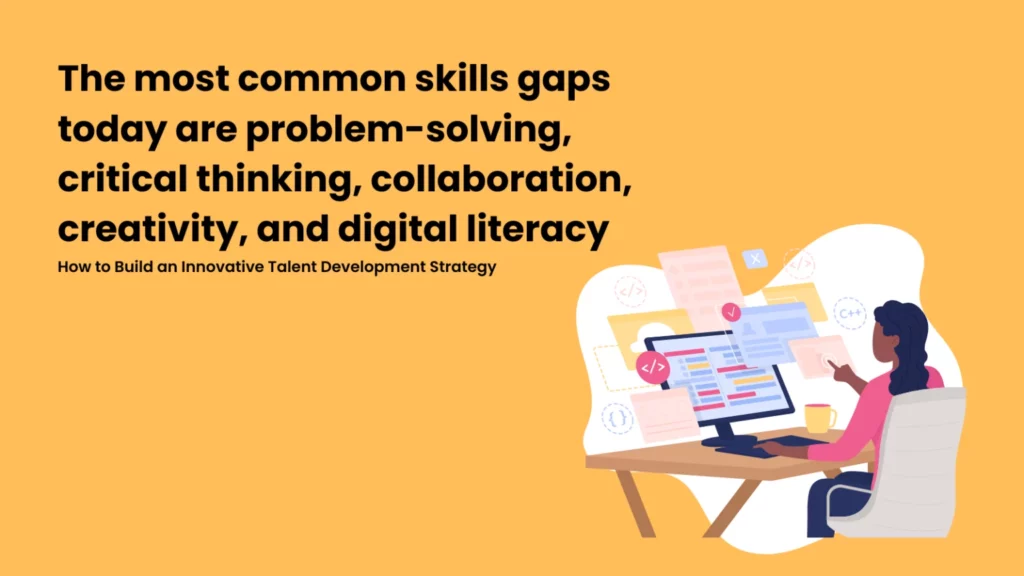While some leaders invest in dedicated R&D teams to drive innovation, you can use talent development programs to foster innovation within your organization.
Talent development programs can help you build a culture of learning and innovation among individuals, teams, or company leadership, integrating innovative thinking into the fabric of your organization.
Here’s a step-by-step outline of how to build an internal talent development program for innovation:

1. IDENTIFY SKILLS GAPS
Start by conducting a skills gap analysis to identify areas where your employees may have weaknesses. Keep in mind that the most common skills gaps today include problem-solving, critical thinking, collaboration, creativity, and digital literacy.
Here are some measures you can take to conduct a thorough skills gap analysis:
- Start by establishing key facts about your company, including mission and values, and set clear expectations for employees that align with those values.
- Identify employee strengths and weaknesses through discussions or observations of their work, and compare their current skills with company expectations.
By starting with skills gaps, you can identify where your talent development program should focus, providing the necessary context and direction for its success.

2. ESTABLISH COMPANY GOALS
Once you’ve established skills gaps, take a minute to delve into your company’s goals. If you haven’t specified them already, take some time to identify your short-term and long-term objectives, quantifying them when possible.
Understanding your company’s needs helps your talent development program support those goals.

3. ESTABLISH EMPLOYEE GOALS
Just as it’s important to establish clear company goals, it’s equally crucial to understand your employees’ goals. Set up one-on-ones with your employees to identify where their personal and professional objectives align with the needs of the company.
A well-designed talent development plan should benefit both your company and your employees, so understanding their needs is critical to its success.

4. ANALYZE TEAM COLLABORATION
Once you’ve identified your company and employee goals, take time to observe and evaluate your team’s collaboration skills. How does your team divide tasks, negotiate decisions, and combine their unique abilities?
Collaboration is a key to the workplace, and in itself is one of the most valuable soft skills lacking in the job market. Understanding how your team collaborates will provide important context for your choice of talent development strategy.

5. CHOOSE A STRATEGY
By now, you should have your enough key facts to get started: employee skills, skills gaps, company culture, company goals, employee goals, and collaboration skills.
These data points will help you choose whether your talent development should focus on management, teams, or individual team members.
- Individual talent development works best when your employees need to develop hard skills that can be attained without collaboration. However, it’s also the most time and resource-intensive option, so make sure your company is ready to take it on.
- Managerial talent development focuses on improving skills among your team’s leadership. This approach makes sense when the most impactful skills gaps are present within your management team.
- Team talent development works best when you want to develop soft skills, like problem-solving, critical thinking, collaboration, and creativity. Team talent development also lets you to leverage challenge-based learning.
Each approach has its pros and cons, and can be combined with each other to build a strategy that meets your specific needs.

6. CHOOSE INNOVATION EXERCISES
Your chosen strategy will inform which exercises to use for your talent development objectives. You have a wide range of options available, including innovation challenges, problem-solving exercises, interactive workshops, seminars, and collaborative activities.
Instead of focusing on any one approach, it often makes sense to select and combine exercises in a way that complements the strategies you’ve chosen for your talent development program.

7. TAILOR INNOVATION EXERCISES
One great advantage of running your talent development program internally is the ability to customize the program to your organization’s specific needs.
This includes aligning the the program with your company’s unique culture, mission, values, and goals, as well as considering your employees’ skills sets, skills gaps, and individual goals.
For instance, if your company culture emphasizes passion and ambition, you can design innovation challenges that allow employees to choose an issue they are passionate about solving.

8. SUPPORT TALENT DEVELOPMENT
Once you have established your goals, strategy, and methods, the next crucial step is to provide continuous support to your team as they go through the talent development program.
Regularly checking in with team members, providing constructive feedback, and breaking down any organizational barriers can greatly support their growth and progress.
Monitoring progress and providing support can help employees stay on track and foster a supportive company culture.
By following these steps, companies can create an innovative talent development program that aligns with their goals and fosters a culture of innovation in the workplace.

Want to start your talent development program?
Learn how you can reduce skills gaps, improve team retention, and accelerate company performance by deploying an internal talent development program.

